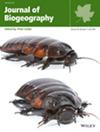Spatial Variation and Climatic Correlates of Phylogenetic Diversity and Dispersion of Butterfly Faunas Worldwide
Abstract
Aim
Investigating the relationships between measures of phylogenetic structure and environmental variables can help us understand the variation in species richness and phylogenetic structure in biological assemblages. Here, we analyse a comprehensive data set for butterfly faunas to explore the relationships of phylogenetic diversity and dispersion with climatic variables across the world in order to understand how climatic factors might have played a role in driving geographic patterns of metrics of phylogenetic structure in butterfly assemblages.
Location
Global.
Taxon
Butterflies.
Methods
For butterfly assemblages in each grid cell of 100 km by 100 km, phylogenetic diversity was measured as mean pairwise distance, and phylogenetic dispersion was measured as the standardised effect size of mean pairwise distance. These two metrics were related to six variables representing current climatic conditions and two variables representing historical (Quaternary) climate change.
Results
We find that phylogenetic diversity and dispersion increase with increasing mean annual temperature; current climatic variables are stronger drivers of phylogenetic diversity and dispersion than Quaternary climate change variables; temperature-related variables are stronger drivers of phylogenetic diversity and dispersion than precipitation-related variables; and climate extreme variables are stronger drivers of phylogenetic diversity but weaker drivers of phylogenetic dispersion than climate seasonality variables.
Main Conclusions
In most cases, the geographic patterns and climatic associations of phylogenetic diversity and dispersion in butterflies found in this study are consistent with those found in previous studies for angiosperms, which may be, to some degree, caused by the co-evolution of these two groups of organisms.

 求助内容:
求助内容: 应助结果提醒方式:
应助结果提醒方式:


